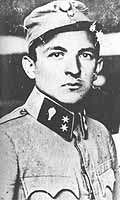Johann Risztics
Stabfeldwebel Johann Risztics (aka Janos Risztics) was the Austro-Hungarian World War I flying ace credited with seven reliably confirmed aerial victories. During 1918, Risztics formed a strong friendship with fellow pilots Fredrich Hefty and Ferdinand Udvardy. Amongst the airmen of Flik 42J, the trio became known as the Arany Triumviratus (Golden Triumvirate).
Johann Risztics | |
|---|---|
 Johann Risztics | |
| Nickname(s) | Api |
| Born | 11 January 1895 Budapest, Hungary |
| Died | March 7, 1973 (aged 78) Duisburg, Germany |
| Buried | Duisburg, Germany |
| Allegiance | Austro-Hungarian Empire |
| Service/ | Aviation |
| Rank | Stabfeldwebel |
| Unit | Flik 22, Flik 42J |
| Awards | 1 Gold and 1 Silver Medal for Bravery |
Risztics marked both sides of his Albatros D.III with the number "8", Udvardy with the number "7", and Hefty with the number "6".[1]
World Record Flights of the W33
In the late 1920s, he was well known for his record flights for the Junkers W 33.
On July 5, 1927, Junkers pilots Risztics and Zimmermann achieved a new world record for continuous flight with a W33L of 65hrs and 25 minutes.
Risztics and Edzard achieved the next W33 world record on August 3, 1927 with a W33. They flew for a distance of 4660 km a new distance world record, and needed 52hrs and 22 minutes for that flight.
First try of the east-west Atlantic crossing
On August, 14th 1927, Risztics, Edzard and the American journalist Hubert Renfro Knickerbocker on board the Junkers W 33 "Europa", and Koehl, Loose and Huenefeld with the W 33 "Bremen", took off from Germany for the first approach of the crossing. This approach failed due to bad weather and engine troubles of "Europa".
The Challenge 1929-1930
Risztics took part at International Touring Aircraft Contests, the Challenge 1929 and the Challenge 1930. The contest was conceived by the French Aero Club, inspired by the International Light Aircraft Contest in France in 1928. Four Challenges, from 1929 to 1934, were major aviation events in pre-war Europe.
The first contest was opened on August 4, 1929 in Paris. It consisted of two parts: technical trials of aircraft and a rally over Europe. Since one of the aims of the Challenge was to generate a progress in aircraft building, it was not only pilots' competition, but technical trials also included a construction evaluation.
Fifty-five aircraft entered the Challenge in 1929, from six countries. All planes flew with two-men crews, pilot and passenger or mechanic.
Johann Risztics was 8th after the technical trials with his Junkers A50. However, just at the beginning of a rally over Europe, on 7 August 1929, he broke undercarriage and propeller and was disqualified. He continued the rally off the contest, till Milano.[2]
The second Challenge took place between July 16 and August 8, 1930 and started in Berlin, Germany.
Germany organized the contest, because the German pilot Fritz Morzik won the previous contest in 1929. Sixty aircraft entered the Challenge in 1930, from six countries.
The contest was open on July 16, 1930, at Berlin-Staaken airfield. It consisted of two parts: a rally over Europe and technical trials.
Risztics finished the rally on the 16th position and all the contest on the 15th position, flying Junkers A50ce.[2]
See also
References
- http://www.theaerodrome.com/aces/austrhun/risztics.php
- (in Polish) Marian Krzyżan: "Międzynarodowe turnieje lotnicze 1929-1934", Warsaw 1988, ISBN 83-206-0637-3, p. 23, 27, 59